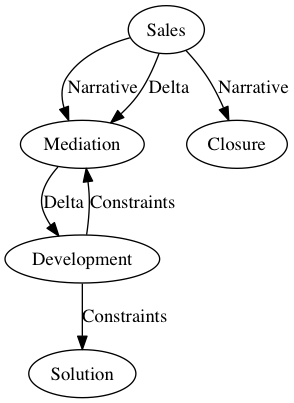Separation of Sales and Development Roles
Something counter-intuitive occurs when you take someone versed in sales and in development and ask them to do both on a project. There are two forces at play that are very productive if they can be resolved - narrative forces, and the scientific forces. Sales tells a lead a story where the lead is the main character. This doesn’t focus on the obstacles to engineering the details that the story entails by design. Sales is about driving desire. Of course, the pitch must be achievable at least in part otherwise reputation will suffer, but the constraints of the story need not be made explicit to the lead. Development on the other hand focuses almost entirely on uncovering the constraints of the solutions described. The tension between vision and realisation can be a very productive driving force for a business, but only when managed carefully. The division of roles aids in this management in ways that are very difficult to manifest in a single person.
This tensile force hampers both sales development and if a boundary is not established. How does this happen? In the sales capacity, when in the process of chasing and closing leads, a sales pitch is hampered by the inherent conservatism of the integral development mindset of constraint discovery and resolution. A developer must be thinking at all times - “Why won’t this work?” - and when constraints have not been discovered the usual attitude is to fall back on a reluctance to provide estimates until these constraints are unearthed. In a development capacity, when building the solution, the promises made during the sales process will create a cognitive-dissonance which prevent the scrutiny of the constraints surrounding the solution that would lead to the quickest illumination of dead-ends.

A split-personality is required In order to maintain both of these mindsets without dampening the productivity required for the roles. This split simply shuts off the sales or development mindset as the situation demands - much easier said than done. An external perspective on where the forces are out of alignment can provide a more objective view on the “delta” forces required to restore the balance to within productive limits. Of course, these forces are not at play, at least not to a significant degree, when selling an already established product. This is because an understanding of what the product can deliver is already largely fleshed-out, and there really isn’t any development work left to complete besides any integrations required.
What’s the take-away from all this ruminating? For management I suppose that it helps clarify the value of the separation of roles. For an individual who is acting in both a sales and development capacity it should show that the careful cultivation of operational modes and mindsets can be extremely useful - although a bath of fire should cement this intuitively, it still pays to reflect on what exactly causes this as the natural response to conflicting dynamics.
